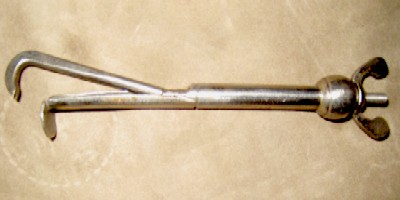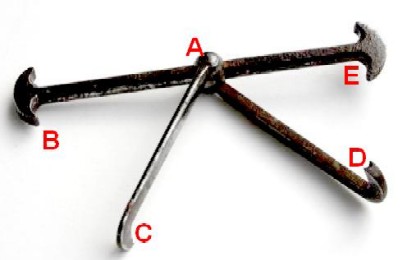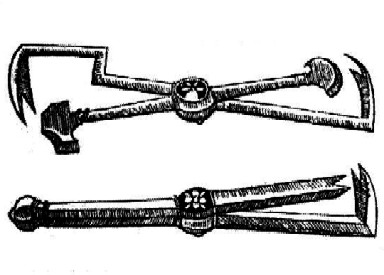
Charles Allen's Polican (Dental Pelican)
In the Golden Age of Piracy (~1685 to 1725) very little had been published in England about Dentistry. The first known English book on the topic was Charles Allen's book The Operator for the Teeth. The book focused a great deal on theories of tooth decay and other dental matters. Much of this theory is irrelevant to modern audiences. However I found that he also provided us with an interesting description of a very common tooth extraction device from this period: the dental pelican.
Dental pelicans started going out of fashion with the invention of the dental toothkey in 1742.

Mission's reproduction adjustable dental pelican
Part of the problem with the pelicans as I understand it was they caused the accidental loosening or removal
the teeth next to the tooth
targeted to be taken out- something Allen mentions in his book. This is because the type of pelican that Allen
decribes would have the bolster (the part of the tool which rested on the gum beneath the tooth) positioned on
the teeth next to the one being removed. You can see an excellent drawing of this
here. (It is
not reproduced here so as not to violate copyright.)
Allen also gives a pretty good description of how the thing was designed to be used for different sizes of teeth, informing the curious design of these devices. I am not sure if a 'line' had a standard dimension or not, but it helps in the understanding of how a pelican would work. Later pelicans (like the one I had made for my surgical collection which you see here) would be adjustable to match the exact width of the tooth removed.
I thought I would present it here in full. As usual, I am preserving the spelling and grammar. I have inserted some paragraph breaks that aren't in the original to make it more readable for on-line audience. I am also including letters so that you can reference the parts being described in the photograph. Allen is describing a two headed dental pelican like the one you see in that photo below. This is appropriate as it seems to have been one of the most popular models.
Allen's Description
"The Description and Use of the Polican [dental pelican].
The Construction, and usual shape of the Polican, is a thing so well known by every body, that
it wou'd be needless to insist at all upon it. And therefore, without losing time in such
superfluous Discourses, we shall here take notice of some other things appertaining to the said
Instrument, more material and useful:
as the due proportion that its parts ought to have, considered in themselves, and in respect of each other.
In the first place, then, (supposing that you know the stuff wherewithal it must be made, which ought to be a tough steel, or steel and iron together)

A double-headed dental pelican lettered for reference
let the tree of the Polican be about four inches long, and so perforated that the distance betwixt the centre of the hole [A] (wherein goes the pin, upon which are fastened the two branches [B & E]) and one of the extremities [D], be a line greater than the other. Let one of the two branches [B] be two lines longer than the other; let also each claw [I believe he's referring to the the claw on the end, not the whole arm] be three lines long. [Note that this gives you an idea how long a 'line' is - about 1/3 the length of each claw.] And finally, let the distance between the bolster [the moon-shaped part on the end of the two branches], or semicircle of the longest side of the tree [B], be two lines; And you will have four distances between the claws and the bolsters, which is sufficient to draw all sorts of Teeth.
For with the first, which is of two lines, you may draw the Incisors. With the second, of three lines, you may draw the Canini. With the third, of four lines, Double and Treble Teeth. And with the fourth, of five lines, the Quadruple ones.

A double and single pelican from a period source
Your Polican being thus made, if you have a mind to use it, you must so apply the Claw to the
inside of the Tooth you intend to pull out, that its branch may stand exactly upon the middle of
the said Teeth, gently leaning your Bolster upon the [tooth] next to it, the better to take your
measures; and then draw obliquely, but in a direct line from the Tooth outwardly; for in
drawing laterally, you might chance so to force the Tooth to be drawn, upon the next to it, that
you wou'd draw them both together, or at least loosen very much the sound one, and put a far
greater force upon the other in drawing it, than is necessary. Which wou'd occasion an infinitely
greater pain to the Patient, than if you had done it rightly.
Thus much I have thought fit to tell you concerning the nature and use of the Polican; which if you observe punctually, you need never fear the Drawing well of any Tooth." (Charles Allen, p. 17-8)

